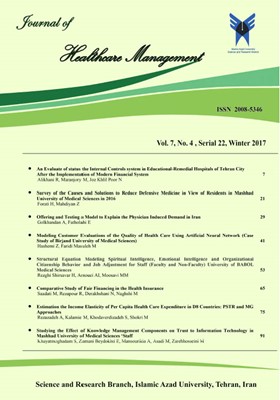-
-
List of Articles
-
Open Access Article
1 - An Evaluate of status the Internal Controls system in Educational-Remedial Hospitals of Tehran City After the Implementation of Modern Financial System
Razeyeh Alikhani mehdi Maranjory Noshin Joz Khlil poor -
Open Access Article
2 - Survey of the Causes and Solutions to Reduce Defensive Medicine in View of Residents in Mashhad University of Medical Sciences in 2016
Hossein Forati Zahra Mahdiyan -
Open Access Article
3 - Offering and Testing a Model to Explain the Physician Induced Demand in Iran
Abvalqasem Golkhandan Elaham Fatholahi -
Open Access Article
4 - Modeling Customer Evaluations of the Quality of Health Care Using Artificial Neural Network (Case Study of Birjand University of Medical Sciences)
Zahra Hashemi Marzieh Faridi Masuleh -
Open Access Article
5 - Comparative Study of Fair Financing in the Health Insurance
mohammad saadati ramin rezapour naser derakhshani maryam naghshi -
Open Access Article
6 - Estimation the Income Elasticity of Per Capita Health Care Expenditure in D8 Countries: PSTR and MG Approaches
Ali Rezazadeh moohamad Kalamie Saber Khodaverdizadeh Mostafa Shokri -
Open Access Article
7 - Studying the Effect of Knowledge Management Components on Trust to Information Technology in Mashhad University of Medical Sciences ‘Staff
Saeed Khayatmoghadam Ismail Zamani Beydokhti Abolfazl Mansourikia Mahbuobe Asadi Maryam Zarehhosseini
-
The rights to this website are owned by the Raimag Press Management System.
Copyright © 2021-2025







